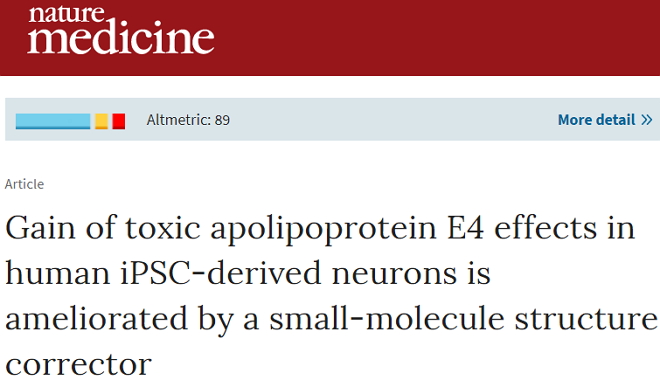Release date: 2018-04-12

Image source: Pixabay
The study was published in the journal Nature Medicine on April 9th ​​under the title "Gain of toxic apolipoprotein E4 effects in human iPSC-derived neurons is ameliorated by a small-molecule structure corrector". Scientists from the Gladstone Institute revealed details of apoE4 increasing the risk of Alzheimer's disease.
More importantly, the research team found a solution to use a small molecule to transform the harmful apoE4 protein into a harmless protein similar to apoE3, thereby eliminating brain damage caused by apoE4.
ApoE4 vs ApoE3
The ApoE protein (apolipoprotein E) is a protein involved in cholesterol metabolism and trafficking. Its coding gene ApoE has three major alleles: ApoE2, ApoE3 and ApoE4. Compared to the most common apoE3 gene, when carrying a copy of the apoE4 gene, the risk of developing Alzheimer's disease more than doubled, and the risk of carrying two copies increased by a factor of 12.
Although the apoE4 protein is only a little different from the apoE3 protein, this change is enough to change its main structure and thus its function. Scientists have been unclear why apoE4 protein damages brain cells more than other versions of the protein.

Doi:10.1038/s41591-018-0004-z
New research to change ideas
Alzheimer's disease has always been a "sad place" for drug development. Many drugs show great hope in animals, but they are "distracted" in clinical trials. These failures led Yathuang Huang, director of the Transformation Center at Gladstone Institute, and senior researcher to reflect on the choice of model – in the new study, he decided to use human cells to simulate disease.
How to build a cell model? Yadong Huang and the team used "inducible pluripotent stem cells" technology, which collected skin cells from AD patients (carrying two copies of the apoE4 gene), reprogramming them, and differentiating them out of nerve cells. At the same time, they also carried two copies of the apoE3 gene using healthy human skin cells as controls.
The results show that in human neurons, the malformed apoE4 protein does not function properly and is broken down into fragments that damage nerve cells. This process leads to the accumulation of Tau protein and β-amyloid.
This result is surprising because previous studies in mouse models have shown that apoE4 does not alter amyloid accumulation in neurons of dementia mice. However, in human cells, apoE4 significantly promotes amyloid production. This means that apoE4 has significant species differences in controlling amyloid metabolism.
In the first article, Dr. Chengzhong Wang believes that this difference may explain the different outcomes of drugs in animal and clinical trials and provide important information for future drug development.
How does ApoE4 damage neurons?
apoE4 does cause cell damage associated with Alzheimer's disease. But how does apoE4 damage cells? Is it because of the presence of apoE4 that the lack of normal function of apoE3 or apoE4 directly added toxic side effects? This is still unknown.
“It’s important to solve this problem fundamentally because it will change the way you solve problems.†Yadong Huang believes, “If nerve damage is due to protein loss, we may be able to compensate for the loss by upregulating specific protein expression. Because of the accumulation of apoE4 leading to toxic side effects, it can prevent damage by inhibiting the accumulation of apoE4."
To answer this question, the researchers examined brain cells that did not express either apoE protein and found that they have the same shape and function as cells expressing apoE3. However, once apoE4 protein is artificially added, it is easy to cause pathological features associated with Alzheimer's disease. This means that the presence of apoE4, rather than the absence of apoE3, contributes to the disease.
Find a corrective method
The cause of the disease was clarified and the research team began looking for ways to fix it. In an earlier study, Yadong Huang and collaborators developed a compound that alters the structure of the apoE4 protein and transforms it into a harmless protein similar to apoE3. They called this molecule apoE4's "structure correctors."
The results confirmed that treatment of neurons carrying apoE4 with this compound can eliminate pathological symptoms associated with dementia, restore normal cell function, and improve cell survival.
At present, Yadong Huang is continuing to cooperate with colleagues in academia and industry, hoping to optimize the compound and bring it to the clinic for the benefit of patients as soon as possible.
Reference materials:
Scientists fix genetic risk factor for Alzheimer's disease in human brain cells
Source: Bio-Exploration
Foot Protective Shoes,Leather Safety Shoes,Smash Proof Work Shoes,High Cut Safety Boots
Dongying Hong Xing Labor Protection Products Co.,Ltd. , https://www.hongxinglabor.com